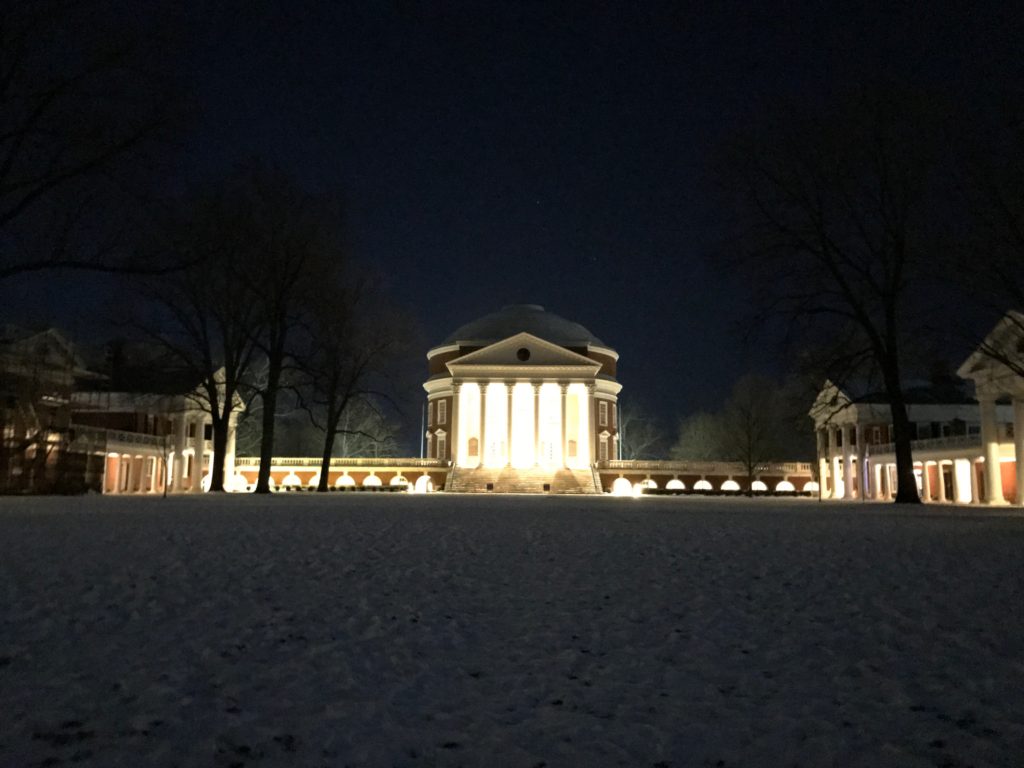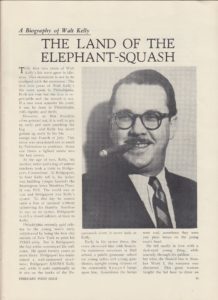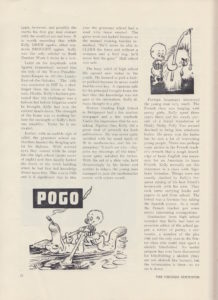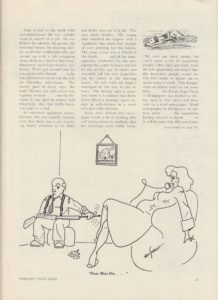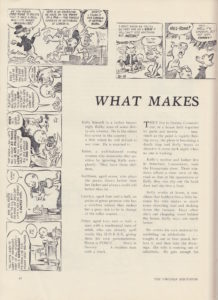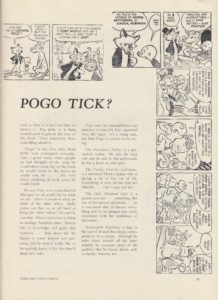Full copies (in PDF) of Nat Hentoff’s short-lived magazine The Jazz Review available at Jazz Studies Online. Just look at the table of contents for the first issue…
Author: Tim Jarrett
Listening: Kate Tempest, KEXP live performance
I’m an occasional podcast listener. I subscribe to a handful, all music, including the mighty Funky16Corners and Iron Leg and a few from KEXP. Because all three of these have some shows that last a half hour or more—typically longer than my commute—I tend to binge-listen to catch up.
I had a long drive down to North Carolina starting Sunday and took the opportunity to catch up on my listening. I almost fast forwarded past the KEXP live sessions entries, but I’m glad I didn’t. Something about the announcer made me want to listen to the first episode I had downloaded, from an artist named Kate Tempest.
What an amazing session. Twenty-five minutes or so of live hip-hop and spoken word, telling the story of a group of Londoners and their lives at 4:18am. The net effect is somewhere between The Streets and Hamilton for the immediacy of the verbal portraits and the breadth of the impact. Well worth checking out.
Ten years ago…
…(yesterday), the iPhone was announced. I went looking through my blog archives, and found my reaction.
Particularly funny is reading, after-the-fact, the commentary claiming that Nokia, Blackberry and others had such a big lead in mobile device design. Ten years on, it’s even more apparent than ever that all mobile prior to the iPhone was just a prelude. And every successful device since then has leveraged the same design architecture—big touchscreen, flat device, minimal hard buttons—whether from Apple or from any one of a galaxy of imitators.
I rewatched the launch announcement last night … on my current iPhone.
Travel day
Et tu, Virginia?
RIP Nat Hentoff
Sorry to hear about the death of jazz critic and free speech advocate Nat Hentoff. Ninety-one is a good run, by any measure, but we need his contributions more than ever.
Cocktail Friday: Midwinters 1951 recipes
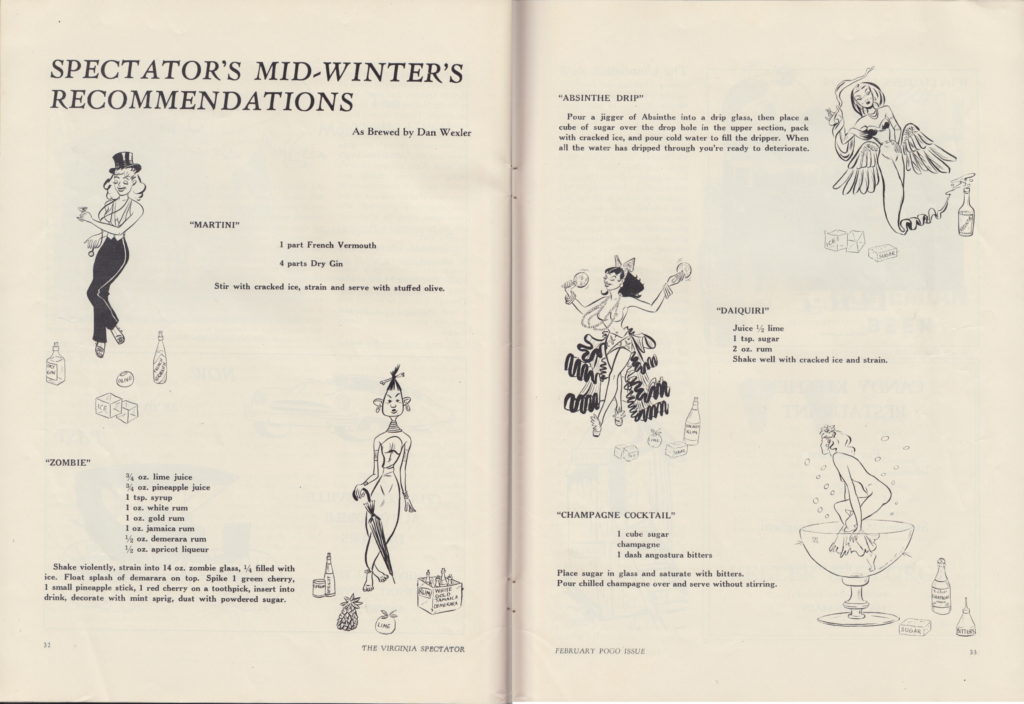
I’m still working my way through the February 1951 Virginia Spectator, which has some interesting treasures beyond the Pogo-related content we wrote about yesterday. In particular, here’s a set of cocktail recommendations for Midwinters drinking, proving that straight bourbon and beer didn’t always prevail (though certainly “Mad Men” style sexism did).
In fact, as one might expect from the mid-century period, there’s no bourbon in any of these cocktails, or any dark liquor at all (aside from a little rum). None of these cocktails is fancy, but they’re mostly true to their models—with the possible exception of the fruit salad on the Zombie. Enjoy!
Martini
- 1 part French Vermouth
- 4 parts Dry Gin
Stir with cracked ice, strain and serve with stuffed olive.
Zombie:
- 3/4 oz lime juice
- 3/4 oz pineapple juice
- 1 tsp. syrup
- 1 oz white rum
- 1 oz gold rum
- 1 oz Jamaica rum
- 1/2 oz demerara rum
- 1/2 oz apricot liqueur
Shake violently, strain into 14 oz zombie glass, 1/4 filled with ice. Float splash of demerara on top. Spike 1 green cherry, 1 small pineapple stick, 1 red cherry on a toothpick, insert into drink, decorate with mint sprig, dust with powdered sugar.
Absinthe Drip
Pour a jigger of Absinthe into a drip glass, then place a cube of sugar over the drop hole in the upper section, pack with cracked ice, and pour cold water to fill the dripper. When all the water has dripped through you’re ready to deteriorate.
Daiquiri
- Juice 1/2 lime
- 1 tsp sugar
- 2 oz rum
Shake well with cracked ice and strain.
Champagne Cocktail
- 1 cube sugar
- champagne
- 1 dash angostura bitters
Place sugar in glass and saturate with bitters. Pour chilled champagne over and serve without stirring.
Virginia Spectator: “February Pogo issue”
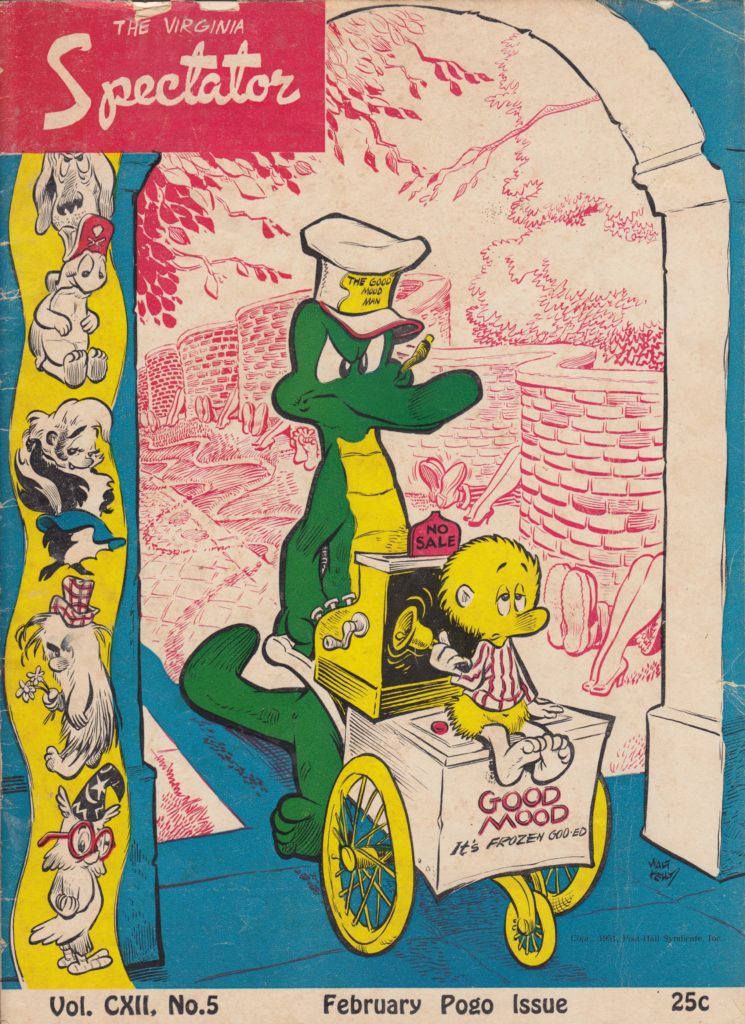
As previously mentioned, I now have my copy of the February 1951 Virginia Spectator, the “Pogo issue” of the University of Virginia student magazine that started out as the literary magazine (jointly published by the Jefferson and Washington Societies) but was by the 1950s more a college humor magazine with the occasional short story thrown in.
Calling this the “Pogo issue” is based on the incredible Walt Kelly UVa-themed cover (above) which I’ve discussed once or twice before, plus the inclusion of two articles: a biography of Walt Kelly and a discussion of the characters in his most famous comic strip. “The Land of the Elephant-Squash,” of which the first three pages are reprinted below, was later reprinted in the Okefenokee Star fanzine and in Fantagraphics reprint collections. “What Makes Pogo Tick?” is less often reprinted. Reading both, there is nothing to tie them to Virginia, but this appears to be the first time both appeared in print.
I’ve scanned several more of the pages in the issue into this Flickr album. Enjoy…
New year, new resolutions
Here we are at the beginning of 2017. Last year I made my first ever public New Years resolution. It’s a time to check in on how I did and to do the next turn of the page.
The resolution last year was an easy one: write more, on my blog. It was easy because I wanted to do it. It was hard because it meant finding time to do it. But I managed to pull it off. I did a statistical check-in back in September on how I did, and reached the conclusion that I was keeping to the goal of writing every weekday at about an 88% success rate. I finished the last four months of the year at 92% average, thanks to a very strong September. So yay me!
The reward was substantial in other ways as well. I started finding writing was easier, both on the blog and at work, and started finding it easier to dig deeper and say more interesting things. That later in the year I got my first public speaking conference slots, in New York, Bristol, and Seville, I attribute at least in part to this trend. That is a classic unexpected outcome to a relatively simple change in habit.
Personally, I found the writing took me in some unexpected directions. I knew I liked learning about cocktails; now I like writing about them as well. And on a more serious note, I didn’t start digging deep into America’s history of slavery until this year, when I started finding the fossilized remnants of it lurking just beneath the surface.
So what’s next? This is a harder question. I have some harder habits to change, but I need to change them. First, I need to get more exercise. Second, I need to change my diet to lose some weight.
I’m not committing to how I’m going to do the exercise, but I know how I’m going to measure it. We’re going to close the rings, with a goal of increasing my number of weeks that I close all three.
Regarding the weight thing, I’m not concerned about the amount of weight I want to lose, though I have an idea. Mostly I just want to eat healthier. And I’m going to start with the low hanging fruit: no beer on weeknights. I’m in the habit of drinking beer with dinner, and I think I need to unwind that habit, or at least make it a less frequent thing. Wil Wheaton’s reboot is my inspiration here. I hope I don’t completely go off beer as he did, but I think it’s a reasonable starting point. So we’ll see!
Reverse engineering “Yoda Stories”
Zachtronics: Reverse Engineering Star Wars: Yoda Stories. I spent way too much of my life playing this game back in the 1990s.
Amateur hour in the House
New York Times: The Republican Ethics Vote: What Happened? When swift outrage followed the announcement that the House had quietly voted to dismantle an independent congressional ethics office, I figured it would be like all the times I was outraged about GOP actions: that the action would go forward anyway and our government would get a little shittier. Then Donald Trump weighed in, and this afternoon the House reversed itself.
The New York Times article explains the timeline, but not the cause behind the events. I think we can read this as a clear sign of “amateur hour” syndrome in the House. The Republican leadership spent six years in the majority under Obama, but they didn’t spend it governing. They spent it as though they were a minority opposition party, dedicating themselves to opposing every policy that he took and every initiative he announced. That’s not leadership; that’s protest. That doesn’t prepare you to actually act.
If today is any indication, we’re in for a long line of Keystone Kops style lawmaking out of this Congress.
Eating for luck
I find the New Years Day food tradition fascinating. People who would never dream of touching a collard green in the South smile and eat it on New Years Day—for luck. And it’s the same thing all over the world, just with different ingredients.
In years past, particularly when we lived in the North End of Boston, we adopted the cotechino as our good-luck food—or a variant called the zamponi. Increasingly I’ve been switching it up, though, as a real Italian butcher has become harder to find in the suburbs.
For the last few years we’ve cooked Sea Island red peas, on the recommendation of Greg. Last year I made a pretty delicious soffrito of root vegetables and cooked the peas in it. This year I went back to the same recipe and, reading it more closely, realized that the intent was to use the vegetables to flavor the broth, then discard them. Whoops. I followed the recipe this year, with the small exception of adding a slice of double smoked bacon in small dice (since I didn’t have any ham stock handy), and served them over plain rice since I had used all the Carolina Gold last year. (Mental note: remind me in June to reorder from Anson Mills.)
But was that all we had? Reader, it was not. One of the other classic New Years Day good-luck foods in Asian countries is dumplings, particularly the kind that look like purses full of money. And one of our son’s favorite food groups is dumplings of any variety. So we made tsak sha momos, and other than forgetting the salt they were great! And because we had to go to HMart to get some of the ingredients, we ended up with a smorgasbord of accompaniments, including udon noodles, some bao baos, and bulgogi. With our dishes of red peas alongside. Not a bad way to ring in the New Year.
End of the week link roundup
I’m writing this in the back seat of our minivan on my iPhone, surrounded by a pair of Bichons who don’t travel well. So links are what you’re going to get.
IBM: Migrating security to the cloud: a model for Total Cost of Ownership. I thought I had seen all the models for savings from adopting SaaS products, but this one adds a few factors I hadn’t considered.
Aeon: Why bullshit is no laughing matter. In passing, this article uses tweets by Deepak Chopra to illustrate the qualities of BS and calls out some reliable signs of it: “The words … are unnecessarily complex, and the intended meanings are not obviously clear. Perhaps the tweets have been constructed to impress rather than inform. Chopra might have used vagueness as a tool to elicit profundity.”
Doom and Gloom from the Tomb: Invisible Hits 2016. Roundup of interesting Pitchfork articles from the bootleg folks.
Smithsonian: Listen to JRR Tolkien read songs and poems from the Lord of the Rings. Um, yes please.
Evaluating Paul Goodloe McIntire
Following yesterday’s link regarding the possible fate of the Confederate war statues donated to the City of Charlottesville by Paul Goodloe McIntire, I thought it might be worthwhile to dig a little deeper. Was McIntire, a huge donor to both the city and the University of Virginia, a virulent racist like composer and white supremacist John Powell?
It seems many have been asking the same question, and as you might expect the evidence of his intent is a little murky.
Let’s start with the facts. McIntire, after having made his fortune on the New York Stock Exchange, returned home to Charlottesville and started giving away that fortune. In addition to the school of fine arts, the amphitheater, and other gifts to UVA, he donated land and money for parks in Charlottesville, including two white-only parks (Belmont Park and McIntire Park). At the same time he donated the land for McIntire Park, he also donated the land for the all-black Washington Park.
Was he on the side of white supremacy? Or was he simply endowing all Charlottesville’s citizens, black or white, within the scope of the prevailing legal framework of “separate but equal”?
It’s hard to say. An article in CVille Weekly notes that “he did invite the Confederate Veterans, Sons of Confederate Veterans and the United Daughters of the Confederacy to plan the statue’s [Lee’s] unveiling.” But given the heavy concentration of Confederate veterans in Virginia, was this like inviting the Klan or only like inviting the Disabled American Veterans?
I don’t know if we will ever get a good answer on this, given that people like Ben Railton and Waldo Jaquith have been plumbing it since 2009. But it’s worth continuing to remind ourselves that many who have been held up as civic heroes were also products of their times. And, with Railton, to remember that we have many public spaces dedicated to the narrow Confederate view of history, and to call for more reminders of how life was on the other side.
Your daily “past isn’t even past” update
Cavalier Daily: Final report on Confederate memorials presented to city. Interesting tension between moving the statues of Robert E. Lee and Stonewall Jackson and recontextualizing them, with some unusual voices on both sides.
Interesting, too, to note the association of both statues within a historically segregated park and the donor of both statues and park, namely Paul McIntire, also a major donor to the University of Virginia.

